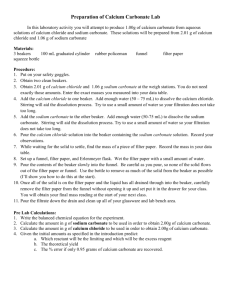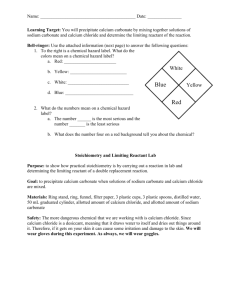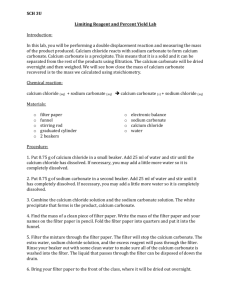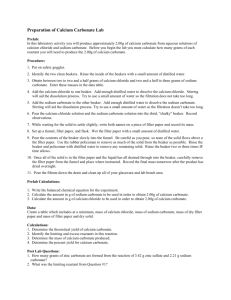Preparation of Calcium Carbonate Lab
advertisement
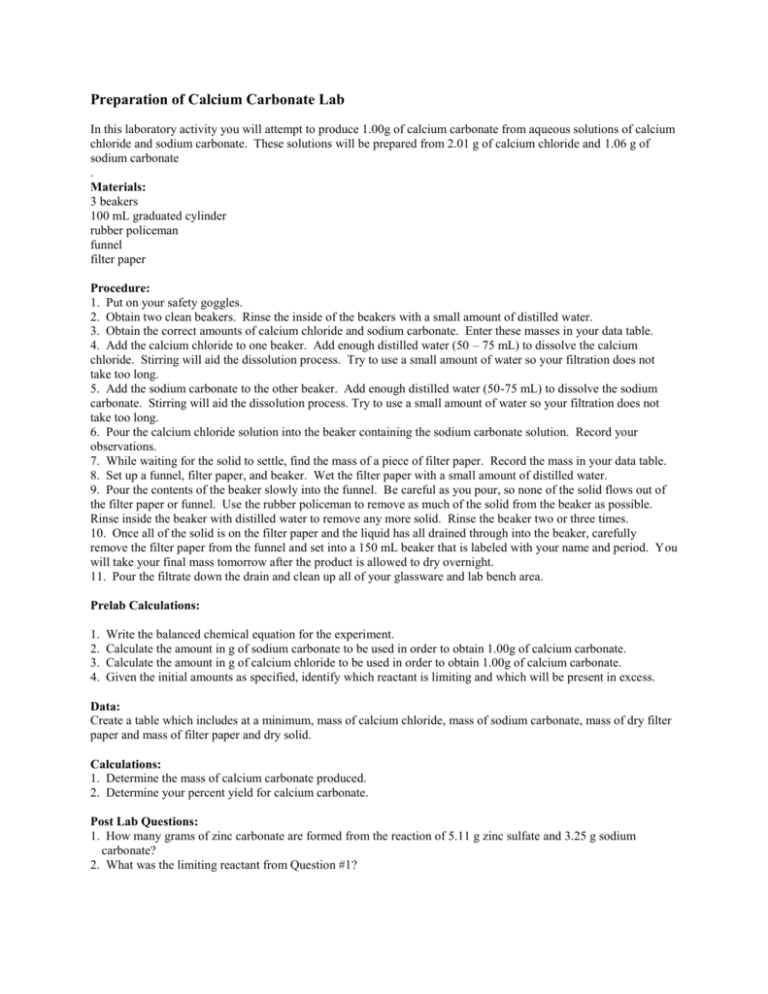
Preparation of Calcium Carbonate Lab In this laboratory activity you will attempt to produce 1.00g of calcium carbonate from aqueous solutions of calcium chloride and sodium carbonate. These solutions will be prepared from 2.01 g of calcium chloride and 1.06 g of sodium carbonate . Materials: 3 beakers 100 mL graduated cylinder rubber policeman funnel filter paper Procedure: 1. Put on your safety goggles. 2. Obtain two clean beakers. Rinse the inside of the beakers with a small amount of distilled water. 3. Obtain the correct amounts of calcium chloride and sodium carbonate. Enter these masses in your data table. 4. Add the calcium chloride to one beaker. Add enough distilled water (50 – 75 mL) to dissolve the calcium chloride. Stirring will aid the dissolution process. Try to use a small amount of water so your filtration does not take too long. 5. Add the sodium carbonate to the other beaker. Add enough distilled water (50-75 mL) to dissolve the sodium carbonate. Stirring will aid the dissolution process. Try to use a small amount of water so your filtration does not take too long. 6. Pour the calcium chloride solution into the beaker containing the sodium carbonate solution. Record your observations. 7. While waiting for the solid to settle, find the mass of a piece of filter paper. Record the mass in your data table. 8. Set up a funnel, filter paper, and beaker. Wet the filter paper with a small amount of distilled water. 9. Pour the contents of the beaker slowly into the funnel. Be careful as you pour, so none of the solid flows out of the filter paper or funnel. Use the rubber policeman to remove as much of the solid from the beaker as possible. Rinse inside the beaker with distilled water to remove any more solid. Rinse the beaker two or three times. 10. Once all of the solid is on the filter paper and the liquid has all drained through into the beaker, carefully remove the filter paper from the funnel and set into a 150 mL beaker that is labeled with your name and period. You will take your final mass tomorrow after the product is allowed to dry overnight. 11. Pour the filtrate down the drain and clean up all of your glassware and lab bench area. Prelab Calculations: 1. 2. 3. 4. Write the balanced chemical equation for the experiment. Calculate the amount in g of sodium carbonate to be used in order to obtain 1.00g of calcium carbonate. Calculate the amount in g of calcium chloride to be used in order to obtain 1.00g of calcium carbonate. Given the initial amounts as specified, identify which reactant is limiting and which will be present in excess. Data: Create a table which includes at a minimum, mass of calcium chloride, mass of sodium carbonate, mass of dry filter paper and mass of filter paper and dry solid. Calculations: 1. Determine the mass of calcium carbonate produced. 2. Determine your percent yield for calcium carbonate. Post Lab Questions: 1. How many grams of zinc carbonate are formed from the reaction of 5.11 g zinc sulfate and 3.25 g sodium carbonate? 2. What was the limiting reactant from Question #1? Preparation of Calcium Carbonate Lab In this laboratory activity you will attempt to produce 1.00g of calcium carbonate from aqueous solutions of calcium chloride and sodium carbonate. These solutions will be prepared from 2.01 g of calcium chloride and 1.06 g of sodium carbonate . Materials: 3 beakers 100 mL graduated cylinder rubber policeman funnel filter paper Procedure: 1. Put on your safety goggles. 2. Obtain two clean beakers. Rinse the inside of the beakers with a small amount of distilled water. 3. Obtain the correct amounts of calcium chloride and sodium carbonate. Enter these masses in your data table. 4. Add the calcium chloride to one beaker. Add enough distilled water (50 – 75 mL) to dissolve the calcium chloride. Stirring will aid the dissolution process. Try to use a small amount of water so your filtration does not take too long. 5. Add the sodium carbonate to the other beaker. Add enough distilled water (50-75 mL) to dissolve the sodium carbonate. Stirring will aid the dissolution process. Try to use a small amount of water so your filtration does not take too long. 6. Pour the calcium chloride solution into the beaker containing the sodium carbonate solution. Record your observations. 7. While waiting for the solid to settle, find the mass of a piece of filter paper. Record the mass in your data table. 8. Set up a funnel, filter paper, and beaker. Wet the filter paper with a small amount of distilled water. 9. Pour the contents of the beaker slowly into the funnel. Be careful as you pour, so none of the solid flows out of the filter paper or funnel. Use the rubber policeman to remove as much of the solid from the beaker as possible. Rinse inside the beaker with distilled water to remove any more solid. Rinse the beaker two or three times. 10. Once all of the solid is on the filter paper and the liquid has all drained through into the beaker, carefully remove the filter paper from the funnel and set into a 150 mL beaker that is labeled with your name and period. You will take your final mass tomorrow after the product is allowed to dry overnight. 11. Pour the filtrate down the drain and clean up all of your glassware and lab bench area. Prelab Calculations: 1. 2. 3. 4. Write the balanced chemical equation for the experiment. Calculate the amount in g of sodium carbonate to be used in order to obtain 1.00g of calcium carbonate. Calculate the amount in g of calcium chloride to be used in order to obtain 1.00g of calcium carbonate. Given the initial amounts as specified, identify which reactant is limiting and which will be present in excess. Data: Create a table which includes at a minimum, mass of calcium chloride, mass of sodium carbonate, mass of dry filter paper and mass of filter paper and dry solid. Calculations: 1. Determine the mass of calcium carbonate produced. 2. Determine your percent yield for calcium carbonate. Post Lab Questions: 1. How many grams of zinc carbonate are formed from the reaction of 5.11 g zinc sulfate and 3.25 g sodium carbonate? 2. What was the limiting reactant from Question #1?

